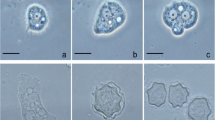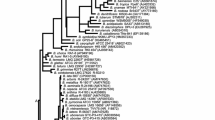Abstract
The obligate intracellular bacteria Wolbachia are taxonomically subdivided into eight supergroups (named A–H). Supergroup typing of strains has been mostly based on phylogenetic inference of the Wolbachia surface protein (wsp), a gene that recently has been shown to experience high rates of recombination. This brings into question its suitability not only for microtaxonomy, but also for supergroup classification of the genus. A Multilocus Sequence Typing (MLST) scheme for Wolbachia has recently been developed that types strains based on five conserved genes, thus providing a rigorous supergroup annotation of strains. Here we report striking discrepancies in supergroup designation between MLST and wsp inferences, and propose a revision of current methods for Wolbachia supergroup typing. Transfer of whole wsp gene sequences between supergroups A and B has occurred. Furthermore, as a result of intragenic recombination, wsp phylogeny creates spurious basal lineages that are not supported by MLST. For example, the proposed supergroup G, based upon wsp alone, likely represents only a wsp recombinant clade. Removal of supergroup G is advised until and unless the existence of this lineage is substantiated by other sequence information (e.g., MLST). We recommend a full characterization MLST for a correct strain typing, while, based on the current data set, use of a single MLST gene can be effective for supergroup designation of A and B strains. Finally, we note that the sharing of wsp sequences between A and B strains indicates a strong genetic cohesiveness of Wolbachia strains, supporting designation of these bacteria within the same species, W. pipientis.



Similar content being viewed by others
Literature Cited
Baldo L, Dunning Hotopp JC, Jolley KA, et al. (2006) Multilocus sequence typing system for the endosymbiont Wolbachia pipientis. Appl Environ Microbiol 72:7098–7110
Baldo L, Lo N, Werren JH (2005) Mosaic nature of wsp (Wolbachia surface protein). J Bacteriol 187:5406–5418
Bandi C, Anderson CG, Genchi C, et al. (1998) Phylogeny of Wolbachia in filarial nematodes. Proc R Soc Lond B 265:2407–2413
Bordenstein S, Rosengaus RB (2005) Discovery of a novel Wolbachia super group in Isoptera. Curr Microbiol 51:393–398
Bouwma AM, Ahrens ME, DeHeer CJ, et al. (2006) Distribution and prevalence of Wolbachia in introduced populations of the fire ant Solenopsis invicta. Insect Mol Biol 15:89–93
Casiraghi M, Bordenstein SR, Baldo L, et al. (2005) Phylogeny of Wolbachia pipientis based on gltA, groEL and ftsZ gene sequences: clustering of arthropod and nematode symbionts in the F supergroup, and evidence for further diversity in the Wolbachia tree. Microbiology 151:4015–4022
Cordaux R, Michel-Salzat A, Bouchon D (2001) Wolbachia infection in crustaceans: novel hosts and potential routes for horizontal transmission. J Evol Biol 14:237–243
Czarnetzki AB, Tebbe CC (2004) Detection and phylogenetic analysis of Wolbachia in Collembola. Environ Microbiol 6:35–44
Dedeine F, Ahrens M, Calcaterra L, et al. (2005) Social parasitism in fire ants (Solenopsis spp.): a potential mechanism for interspecies transfer of Wolbachia. Mol Ecol 14:1543–1548
Goodacre SL, Martin OY, Thomas CF, et al. (2006) Wolbachia and other endosymbiont infections in spiders. Mol Ecol 15:517–527
Haake DA, Suchard MA, Kelley MM, et al. (2004) Molecular evolution and mosaicism of leptospiral outer membrane proteins involves horizontal DNA transfer. J Bacteriol 186:2818–2828
Haine ER, Cook JM (2005) Convergent incidences of Wolbachia infection in fig wasp communities from two continents. Proc Biol Sci 272:421–429
Hall TA (1999) BioEdit: a user-friendly biological sequence alignment editor and analysis program for Windows 95/98/NT. Nucl Acids Symp Ser 41:95–98
Kikuchi Y, Fukatsu T (2003) Diversity of Wolbachia endosymbionts in heteropteran bugs. Appl Environ Microbiol 69:6082–6090
Kittayapong P, Jamnongluk W, Thipaksorn A, et al. (2003) Wolbachia infection complexity among insects in the tropical rice-field community. Mol Ecol 12:1049–1060
Kyei-Poku GK, Colwell DD, Coghlin P, et al. (2005) On the ubiquity and phylogeny of Wolbachia in lice. Mol Ecol 14:285–294
Lo N, Casiraghi M, Salati E, et al. (2002) How many Wolbachia supergroups exist? Mol Biol Evol 19:341–346
Lo N, Paraskevopoulos C, Bourtzis K, et al. (2007) Taxonomic status of the intracellular bacterium Wolbachia pipientis. Int J Syst Evol Microbiol 57:654–657
Maiden MC, Bygraves JA, Feil E, et al. (1998). Multilocus sequence typing: a portable approach to the identification of clones within populations of pathogenic microorganisms. Proc Natl Acad Sci USA 95:3140–145
Malloch G, Fenton B (2005) Super-infections of Wolbachia in byturid beetles and evidence for genetic transfer between A and B super-groups of Wolbachia. Mol Ecol 14:627–637
O’Neill SL, Giordano R, Colbert AM, et al. (1992) 16S rRNA phylogenetic analysis of the bacterial endosymbionts associated with cytoplasmic incompatibility in insects. Proc Natl Acad Sci USA 89:2699–2702
Panaram K, Marshall JL (2006) F supergroup Wolbachia in bush crickets: what do patterns of sequence variation reveal about this supergroup and horizontal transfer between nematodes and arthropods? Genetica 130:53–60
Rowley SM, Raven RJ, McGraw EA (2004) Wolbachia pipientis in Australian spiders. Curr Microbiol 49:208–214
Shoemaker DD, Machado CA, Molbo D, et al. (2002) The distribution of Wolbachia in fig wasps: correlations with host phylogeny, ecology and population structure. Proc R Soc Lond B Biol Sci 269:2257–2267
Sintupachee S, Milne JR, Poonchaisri S, et al. (2006) Closely related Wolbachia strains within the pumpkin arthropod community and the potential for horizontal transmission via the plant. Microb Ecol 51:294–301
Swofford DL (2000) PAUP*: phylogenetic analysis using parsimony (*and other methods). Sinauer Associates, Sunderland, Massachusetts
Urwin R, Maiden MC (2003) Multi-locus sequence typing: a tool for global epidemiology. Trends Microbiol 11:479–487
Werren JH, Windsor DM (2000) Wolbachia infection frequencies in insects: evidence of a global equilibrium? Proc R Soc Lond B Sci 267:1277–1285
Werren JH, Zhang W, Guo LR (1995) Evolution and phylogeny of Wolbachia: reproductive parasites of arthropods. Proc R Soc Lond B Sci 261:55–63
Zeh DW, Zeh JA, Bonilla MM (2005) Wolbachia, sex ratio bias and apparent male killing in the 16 harlequin beetle riding pseudoscorpion. Heredity 95:41–49
Zhou W, Rousset F, O’Neill SL (1998) Phylogeny and PCR-based classification of Wolbachia strains using wsp gene sequences. Proc R Soc Lond SerB 265:509–515
Acknowledgments
We thank Nadia Ayoub for providing Agelenopsis specimens. Funds from the U.S. National Science Foundation grant EF-0328363 supported J.W.
Author information
Authors and Affiliations
Corresponding author
Rights and permissions
About this article
Cite this article
Baldo, L., Werren, J.H. Revisiting Wolbachia Supergroup Typing Based on WSP: Spurious Lineages and Discordance with MLST. Curr Microbiol 55, 81–87 (2007). https://doi.org/10.1007/s00284-007-0055-8
Received:
Accepted:
Published:
Issue Date:
DOI: https://doi.org/10.1007/s00284-007-0055-8




